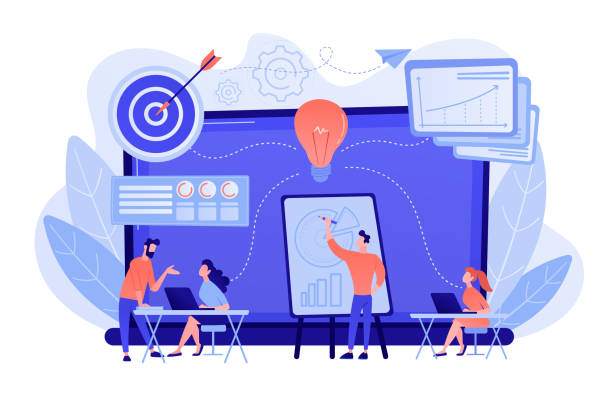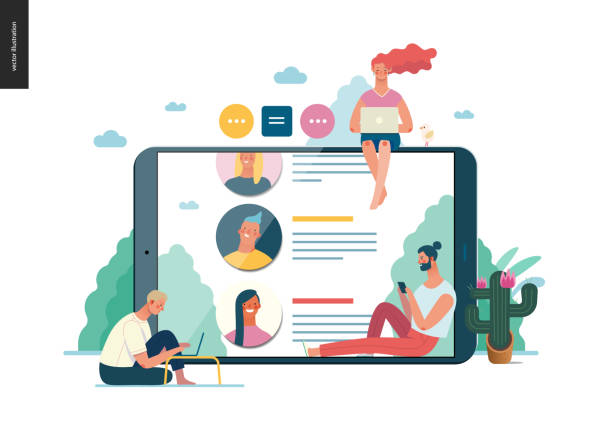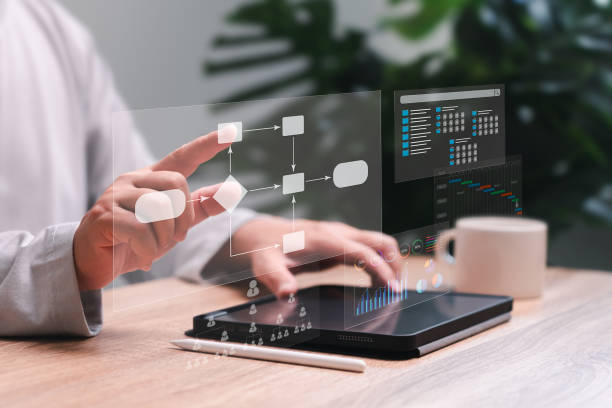Introduction to the Importance of Modern Website UI Design

In today’s digital world, where competition is at its peak and users face countless options, simply having a website is no longer enough.
Your website must go beyond just an online presence; it must create a unique, efficient, and memorable experience for every visitor.
This is where the concept of #Website_Design with modern #User_Interface (UI) and #User_Experience (UX) reveals itself as the cornerstone of success in the digital space.
A modern website UI design is not limited to visual aesthetics; rather, it helps users easily achieve their goals, enjoy browsing the site, and ultimately, become loyal customers.
This approach is not just a fleeting trend but a strategic necessity for any online business in the current era.
The era of complex, confusing, and slow websites is over; today’s users seek simplicity, speed, efficiency, and beauty.
They expect every click, every scroll, and every interaction on the website to convey a sense of satisfaction, efficiency, and professionalism.
In this section, we will explanatorily and educationally examine the various dimensions of this approach and demonstrate how a strong user interface and user experience can make a significant difference in your engagement, conversion rate, and ultimately, brand credibility.
This topic is not merely an aesthetic discussion but a fundamental component in enhancing your website’s performance and competitiveness.
Worried about losing customers because you don’t have a professional e-commerce site?
With e-commerce website design by Rasaweb, forget these worries!
✅ Significant increase in sales and visitor-to-customer conversion rate
✅ Professional and user-friendly design that builds customer trust
⚡ Get free consultation from Rasaweb
Fundamental Principles of User-Friendly Interface Design

To achieve a modern website UI design, one must be well-acquainted with its fundamental principles.
These principles go beyond mere beautiful layouts and attractive colors, focusing on efficiency, ease of use, and the overall enjoyable user experience.
Among the most important of these principles are the following, which we will discuss in detail in the specialized and educational section: The first principle is simplicity and clarity.
A modern user interface avoids any unnecessary complexity and presents information directly, concisely, and understandably.
Users should not have to struggle to find what they need.
Second, consistency and unity.
Various website elements, from buttons and forms to navigation and fonts, must function in a coherent and logical manner.
This unity ensures that the user feels familiar and comfortable in every part of the site and does not get confused.
Third, appropriate and fast feedback.
The system should provide appropriate visual or textual feedback in response to user actions (e.g., clicking a button or filling out a form) so that the user is aware of their current status and feels in control.
Fourth, flexibility and efficiency.
An efficient design should allow both novice users to easily interact with the system and professional users to achieve their goals more quickly.
This includes shortcuts or advanced options for experienced users.
Finally, user control and freedom.
Users should feel that they have control over the system and can revert their mistakes (e.g., a back button or undo option).
Also, adhering to Gestalt principles in visual design, such as proximity, similarity, and continuity, plays a significant role in how users visually perceive page elements and organize information.
These principles help designers provide the best possible experience by considering human psychology and how they interact with digital interfaces.
A successful design is built upon a deep understanding of user needs, expectations, and behaviors, not just superficial aesthetics.
This comprehensive approach is the cornerstone of any successful website that seeks sustained engagement with its audience and aims to make a statement in today’s competitive market.
The Impact of Modern Design on Key Performance Indicators (KPIs)

One of the most important aspects of modern website UI design is its direct and measurable impact on Key Performance Indicators (KPIs) that determine a website’s success.
A website with poor UI/UX can lead to a high Bounce Rate, low Time on Page, and ultimately, a sharp decrease in Conversion Rate, all of which mean losing users and revenue.
Conversely, a modern and optimized website UI design encourages users to spend more time on the site, view more pages, and achieve defined goals (such as purchasing, registering, downloading, or filling out a form).
This topic is particularly important in our analytical section and directly impacts your return on investment.
To better understand these impacts, please refer to the table below, which shows the impact of UI/UX on some of the most important KPIs:
| Key Performance Indicator (KPI) | Description | Impact of Modern UI/UX |
|---|---|---|
| Bounce Rate | Percentage of users who view only one page and then leave the site. | Significant reduction, due to initial appeal, easy navigation, and relevant content. |
| Time on Page/Session | Average time a user spends on a specific page or the entire site. | Increase, due to engaging content, pleasant visual layout, and smooth user flow. |
| Conversion Rate | Percentage of users who complete a desired action (e.g., purchase, registration). | Significant increase, due to optimized user paths, clear calls-to-action (CTAs), and simple forms. |
| Customer Satisfaction | Overall level of user satisfaction with website interaction. | Remarkable improvement, leading to increased loyalty and recommendations to others. |
This table clearly shows that investing in user interface and user experience is not just an expense but a smart and strategic investment that will yield high returns for your business.
For example, designing simpler and clearer registration forms, appropriately colored and positioned CTA (Call-to-Action) buttons, removing distracting elements, and ensuring high loading speed all contribute to improving these indicators.
This is a specialized perspective that every business must consider to succeed in today’s competitive environment.
Leading Tools and Technologies in Modern UI/UX Design

To implement a modern website UI design, familiarity and mastery of current tools and technologies are essential.
This section provides a guide and educational introduction to some of the most important ones that facilitate and accelerate the design and development process.
In the design and prototyping phase, powerful software such as Adobe XD, Figma, and Sketch are designers’ primary tools.
These tools enable visual UI design, creation of interactive prototypes, and easy sharing of designs for feedback.
Features such as live collaboration (in Figma), component libraries, and numerous plugins help designers work faster and more accurately and transform their ideas into tangible designs.
In front-end and web development, JavaScript frameworks like React.js, Vue.js, and Angular help developers build dynamic, responsive, and highly efficient user interfaces.
These frameworks, by offering component-based programming models, state management tools, and rendering optimization, significantly accelerate the development process and enable the creation of complex and smooth user experiences.
Furthermore, the use of Design Systems like Google’s Material Design or Ant Design helps ensure consistency and scalability in design for larger projects, guaranteeing that a modern website UI design remains structured over time and as the project grows.
Usability testing tools like UserTesting and Hotjar also help gather feedback from real users and identify weaknesses in the design.
Smart use of these tools not only simplifies the work of designers and developers but also significantly enhances the final product’s quality and helps accelerate the development process.
The correct selection of tools and technologies is a crucial step in building a competitive and appealing website that can meet the needs of today’s users and provide an unforgettable experience.
Losing potential customers due to an unprofessional website? Rasaweb is your answer! With our specialized corporate website design services:
✅ Elevate your business’s credibility and standing
✅ Experience attracting more targeted customers
⚡ Act now to get a free consultation!
Responsiveness and Mobile Experience in Modern Design

One of the main and indispensable pillars in modern website UI design is the Responsive Design approach.
Given that a large portion of internet traffic today comes from mobile devices, having a website that displays seamlessly and optimally across all screen sizes (from large desktops to tablets and smartphones) is crucial.
This section specially and explanatorily discusses the importance and implementation of this approach.
Responsive design means that your website intelligently adapts its layout, images, fonts, and content to the dimensions and characteristics of the user’s screen.
This is achieved using Media Queries in CSS and flexible structures (Flexbox, Grid) in HTML and CSS, eliminating the need for separate mobile or desktop versions, which is more optimal for both management and user experience.
The concept of Mobile-First Design also holds special importance in this regard and has become an industry standard.
This approach means that the design and development process begins with a full focus on the user experience on mobile devices and their limitations (such as small screen, limited internet speed, touch interaction) and then gradually expands to larger devices (tablets and desktops).
The reason for this is that designing for smaller screen limitations forces the designer to focus on essential content and functionalities and eliminate unnecessary elements.
This approach makes the final website simpler, more efficient, and user-friendly, even on larger screens, as it was designed from the outset with an optimization mindset and the elimination of unnecessary complexities.
Responsive design and the mobile-first approach not only significantly improve the user experience but also play a vital role in Search Engine Optimization (SEO), as Google gives higher rankings and priority to websites that are optimized for mobile in search results.
This is a critical aspect in modern website UI design that should by no means be overlooked for success in today’s world and must be considered a top priority.
The Importance of Accessibility and Inclusivity in Web Design

A truly modern website UI design is not limited to beauty and functionality for the general user; it must also prioritize Accessibility and Inclusivity.
This means designing a website that is usable for people with diverse abilities, including those with visual, auditory, motor, cognitive, or neurological disabilities.
This is not only an ethical and social responsibility but also a legal requirement in many countries and can significantly expand your target market.
In the explanatory and specialized section of this article, we will delve into various aspects of this vital topic.
Adhering to accessibility principles includes several points: Providing alternative text (Alt Text) for images so that screen readers can describe visual content to visually impaired users.
Using appropriate color contrast between text and background for better readability, especially for individuals with visual impairments.
Full keyboard navigability for users who cannot use a mouse.
Providing subtitles or transcripts for audio and video content for hearing-impaired individuals.
Also, a logical and meaningful HTML structure (using Heading tags, Semantic HTML), and providing clear feedback in forms, all contribute to improving accessibility.
Testing with Assistive Technologies like screen readers and magnification software is also a crucial part of the inclusive design process.
An inclusive design not only covers a larger user base and increases the number of potential visitors and customers but also leads to an improvement in user experience for everyone, regardless of their abilities.
A website that is accessible to everyone not only covers a larger market but also presents a positive image of your brand and demonstrates your company’s social responsibility.
This approach is the core of a modern website UI design that is also aware of its social and ethical responsibility and is committed to a comprehensive user experience.
Future Trends in User Interface and User Experience Design

The world of modern website UI design is constantly evolving and innovating, with new trends continually emerging that shape the future landscape of digital interactions.
This section provides a news and analytical overview of some of these upcoming trends that designers and developers should pay special attention to in order to remain competitive.
One of the most important is the integration of Artificial Intelligence (AI) in UI/UX.
AI can significantly enhance the user experience by personalizing content, providing smart recommendations, and automating repetitive tasks (such as customer support via advanced chatbots).
From product recommendation systems to adaptive user interfaces that change based on user behavior, AI is becoming an integral part of modern user interfaces.
Other trends include Voice User Interfaces (VUI), which have gained increasing importance with the growing use of voice assistants like Siri, Google Assistant, and Alexa.
Designing for voice interactions presents its unique challenges but offers unparalleled convenience for users.
Augmented Reality (AR) and Virtual Reality (VR) are also finding their place on the web and have the potential to create immersive and entirely new experiences, especially in areas like online shopping and education.
Micro-interactions – small, subtle animations that provide visual feedback to the user (like an icon changing color on click) – also play a significant role in creating a sense of delight, efficiency, and credibility in the user interface.
Also, Dark Mode, which is not only useful for reducing eye strain in low-light environments but has also become a popular design trend, giving websites a stylish and modern appearance.
The table below shows some of these future trends and their benefits, all moving towards creating smarter, more personalized, and more inclusive user experiences:
| Future Trend | Description | Main Benefits |
|---|---|---|
| AI in UI/UX | Content personalization, smart recommendations, task automation through AI. | Unprecedented personalized experience, higher efficiency in user interactions. |
| Voice UI (VUI) | Interacting with the website via voice commands and spoken responses. | Greater convenience, improved accessibility for some users. |
| Dark Mode | Design with a dark color palette for backgrounds and light text. | Reduced eye strain, lower battery consumption on OLED devices, visual appeal. |
| Micro-interactions | Small animations and subtle feedback in response to user actions. | Increased sense of satisfaction and efficiency, improved user understanding of the system. |
These promising trends indicate that modern website UI design is constantly evolving, and designers and developers must keep pace with these changes to create truly innovative, engaging, and user-friendly experiences for the future.
Anticipating and embracing these trends can position your website at the forefront of innovation.
Challenges and Solutions in Implementing Modern Design

Implementing modern website UI design, while offering numerous benefits and being crucial for success, is not without its challenges.
This section, presented as a guide and thought-provoking content, explores some of these common challenges and offers practical solutions for them.
One of the main challenges is compatibility with various browsers and diverse devices.
What works well in one browser or device may have display or performance issues in another.
The solution is to adhere to web standards and conduct comprehensive and continuous testing across major browsers (such as Chrome, Firefox, Edge, Safari) and various devices (mobile, tablet, desktop) to ensure a consistent experience.
Another challenge is maintaining a balance between aesthetics and performance.
Sometimes, designers focus too much on visual aspects, complex animations, and high-quality images, neglecting website performance (such as page loading speed).
This can harm the user experience.
The solution is to integrate Performance Optimization into the design and development process from the outset; using optimized images and videos, clean and compressed code, utilizing a CDN (Content Delivery Network), and browser cache optimization are among the solutions.
Resistance to change, from the internal team, managers, or even end-users, can also be a significant challenge.
Continuous education and communication about the benefits of modern design, presenting data and results from UI/UX improvements, and consistently gathering feedback from all stakeholders can reduce this resistance.
Also, the complexity of new technologies and the need for continuous team knowledge updates is another challenge.
Investing in team training and skill development, encouraging continuous learning, and attending conferences and webinars are key solutions in this area.
The question arises: how can we ensure that our modern design is not only beautiful but truly useful and practical for users, bringing positive business results? The answer lies in the User-Centered Design approach, continuous testing with real users (Usability Testing), and analysis of behavioral data.
Ignoring these challenges can jeopardize the success of a modern website UI design project and render your investment fruitless.
Does your current website convert visitors into customers or drive them away? With professional corporate website design by Rasaweb, solve this problem forever!
✅ Build strong credibility and branding
✅ Attract targeted customers and increase sales
⚡ Get a free consultation right now!
Successful Case Studies in Modern Web Design

To better understand how to successfully implement modern website UI design and its profound impact on user experience and business success, a look at case studies from leading companies and websites in this field can be highly entertaining, explanatory, and inspiring.
These examples demonstrate how intelligent, user-centered design can revolutionize the digital experience and help achieve key business objectives, and how major brands have embarked on this path.
One prominent example in this field is the Airbnb website and application.
Airbnb’s design is not only visually very attractive, clean, and pleasant, but also features extremely easy navigation and has uniquely simplified the process of searching, viewing details, and booking accommodations for users.
The use of high-quality, full-screen images, a smart and user-friendly filtering system, and a hassle-free payment process with minimal steps all contribute to creating an outstanding user experience.
Their user interface is designed in such a way that even new users quickly connect with it and can easily find the home or experience they desire anywhere in the world, which leads to user trust and loyalty.
Another example is Spotify, the popular music streaming service.
The design of this application and website is shaped by a focus on ease of discovering new music, content organization, and personalization of the user experience.
Its simple yet powerful user interface, along with features such as personalized playlists based on listener taste and smart music recommendations, attracts users and keeps them engaged for hours.
The use of dark colors (in Dark Mode), clear typography, and minimalist icons has resulted in a harmonious, modern, and pleasant visual experience that also makes nighttime use easier.
This design represents a successful modern website UI design that understands and meets the deep needs of users in the best possible way.
These cases teach us that successful design goes beyond mere aesthetics and must meet users’ real needs, solve their problems, and provide them with an enjoyable and hassle-free experience.
These examples are inspiring and can provide practical guidance for your next web design projects, so you too can embark on the path to success.
Continuous UI Testing and Optimization

After implementing and launching a modern website UI design, the work doesn’t end; it merely begins.
Indeed, a successful and dynamic website requires continuous testing and optimization to keep pace with changing user needs and new technologies and to improve its performance.
This section, presented as a guide and specialized discussion, addresses the importance of this topic and effective methods for its implementation.
Usability Testing, which involves observing real users interacting with the website, is one of the most effective ways to identify hidden problems and weaknesses in the user interface.
These tests can provide deep and valuable insights that cannot be obtained solely through statistical analysis, as you observe the actual behavior and thought processes of users.
A/B Testing is also a powerful and data-driven method for optimization.
In this method, two different versions of a specific element (such as the color of a button, the text of a heading, the position of a call to action, or the layout of a page section) are shown to different groups of users, and the performance of each version (e.g., click-through rate or conversion rate) is carefully measured to determine which one leads to better results.
This approach helps you make optimization decisions based on real evidence and objective data, rather than guesswork or personal preferences.
Furthermore, using Web Analytics tools like Google Analytics and Hotjar to monitor user behavior, their navigation paths, bounce rates from specific pages, and click locations provides vital information for identifying areas for improvement.
Tools like Heatmaps and Session Recordings can show you exactly how users interact with your website.
This process is a continuous cycle of design, implementation, testing, feedback collection, analysis, and revision that consistently enhances the user experience and keeps your website vibrant and competitive.
Without continuous testing and optimization, even the best modern website UI design may lose its effectiveness over time and fall behind the changing needs of users.
This data-driven approach keeps your website on the path of progress and ensures that you always provide the best possible experience to your users.
Frequently Asked Questions
| Row | Question | Answer |
|---|---|---|
| 1 | What is meant by “modern website UI design”? | It refers to designing a website that utilizes the latest trends and best practices in user experience (UX) and user interface (UI) to make user interaction simple, engaging, and efficient. |
| 2 | Why is a modern user interface important for a website? | A modern user interface increases user satisfaction, improves conversion rates, increases user retention time on the site, and creates a professional and up-to-date brand image. |
| 3 | What are the key elements of a modern user interface? | Key elements include simplicity and minimalism, responsiveness, use of white space, attractive typography, subtle animations, appropriate color palette, and intuitive navigation. |
| 4 | What role does responsiveness play in modern UI design? | Responsiveness ensures that the website displays correctly on any device (mobile, tablet, desktop) and provides a consistent user experience, which is essential for modern UI. |
| 5 | How important is typography in modern UI design? | Typography plays a very crucial role in readability, visual hierarchy, and brand visual identity. Modern fonts and their combinations can contribute to the overall beauty and appeal of the site. |
| 6 | How are animations and micro-interactions used in modern design? | Animations and micro-interactions are used to create visual feedback, guide the user, and add a sense of dynamism and engagement to the user interface, provided they are not excessive. |
| 7 | What is the role of User Experience (UX) in modern UI design? | UX is the foundation of modern UI. A modern design must first be functional, understandable, and enjoyable (UX) and then beautiful and appealing (UI). |
| 8 | What tools are used for modern UI design? | Tools like Figma, Adobe XD, Sketch, and InVision are used for design, and frameworks like React, Vue.js, or Angular are used for implementation. |
| 9 | How can one avoid overly complex design in modern UI? | By focusing on minimalism, removing unnecessary elements, using ample white space, and adhering to the “less is more” principle. |
| 10 | What is the importance of user testing in modern UI design? | User testing ensures that the designed user interface is truly useful, understandable, and engaging for users, and that potential issues are addressed before launch. |
And other advertising services of Rasaweb Advertising Agency
Smart Link Building: A specialized service for digital branding growth based on key page optimization.
Smart UI/UX: A fast and efficient solution for customer acquisition, focusing on engaging user interface design.
Smart Digital Branding: A fast and efficient solution for increasing website traffic, focusing on smart data analysis.
Smart Google Ads: Transform digital branding with the help of Google Ads management.
Smart SEO: Designed for businesses seeking digital branding through Google Ads management.
And over hundreds of other services in internet advertising, advertising consultation, and organizational solutions
Internet Advertising | Advertising Strategy | Sponsored Content
Sources
User Interface and User Experience Design (UI/UX)
Principles of Modern Website Design
Fundamentals of User Experience and User Interface
Web Design Trends
? For a powerful presence in the digital world, Rasaweb Afarin is with your business, offering the best digital marketing services, including corporate website design.
📍 Tehran, Mirdamad Street, Next to Central Bank, Kazeroon South Alley, Ramin Alley No. 6
